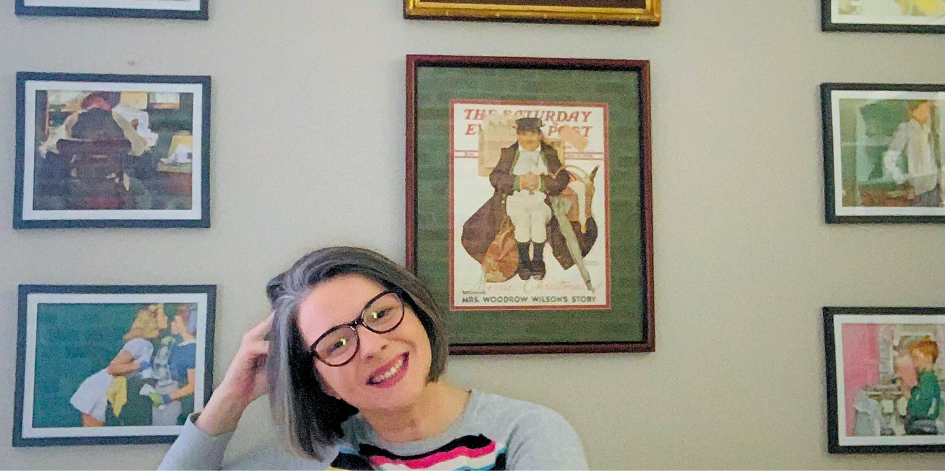There’s something about a blank wall that feels unfinished, as if it’s waiting for a story to unfold. When I first set up my office, I found myself staring at one—a vast space that felt like it should hold more than just paint and possibility. I knew I wanted something vintage-inspired, something with character. But the more I looked at that empty wall, the more it seemed to drain my creativity. I didn’t want to fill it with just anything. I wanted something familiar, something that felt like an old friend keeping me company as I worked.
I wasn’t sure what that would be until my mother handed me a free drugstore calendar. It contained twelve months of Saturday Evening Post covers, each one a small world of its own, painted by Norman Rockwell. She had picked it up on a whim, not realizing it would become the centerpiece of my office.
Each page was filled with children peering through shop windows, families gathered around dinner tables, and barbershops humming with easy conversation. Every scene felt like a love letter to life’s quiet moments—the kind that so often slip by unnoticed. It was an ode to days gone by, a glimpse into a world that felt familiar and just out of reach. And suddenly, I knew exactly what to do with my blank wall.
A box of dollar store frames, a handful of tacks, and an hour later, that simple calendar had transformed into something more—a nostalgic gallery wall, a space that now feels lived in, warm, and full of stories.
Why a Norman Rockwell Wall?
Rockwell’s art captures the beauty of everyday life—the small, familiar moments that make up the heart of a home. They serve as a reminder to slow down and appreciate life’s simplest moments. There’s no rush, no need for grandeur—just the quiet joy of a child’s curiosity, a family’s togetherness, or a peaceful afternoon. It’s a daily reminder to step back and enjoy the present. His work is rich with warmth, humor, and gentle optimism, reminding us that even the simplest moments are worth cherishing.
If you have a blank space of your own, waiting to be filled with something meaningful, here’s how to create a Saturday Evening Post gallery wall of your own.
What You’ll Need:
- A Saturday Evening Post Norman Rockwell calendar (new or old—either will do)
- A set of inexpensive frames (dollar store, thrifted, or ones you already have)
- Scissors or an X-Acto knife (for clean edges)
- A blank wall that’s ready to hold a little bit of history
Step 1: Choose Your Favorite Prints
Flip through the calendar and pick out the images that speak to you. It could be a group of cheerleaders sitting on a bench, leaning in close as they share secrets. Or a woman gazing into her mirror, carefully applying her favorite scent, lost in a quiet ritual. Perhaps it’s a father standing at a train station, holding his hat in his hand as his eager son prepares for his first journey away from home. Each picture shares a story—choose the ones that feel most like yours.
Step 2: Frame Them Simply
There’s no need for fancy matting or expensive frames. Just cut each illustration to fit and place it into a frame. If you like a little character, mix and match wooden, gold, or simple black frame styles. If you prefer cohesion, keep them all the same.
Step 3: Arrange Your Wall
Lay your frames on the floor first, playing with different arrangements before committing to the wall. A neat grid gives a structured, classic feel, while a looser layout makes it feel more personal—like a collection that’s grown over time. I use painter’s tape to do a quick outline and mark the perfect spots on the wall.
Step 4: Hang and Enjoy
Once everything is in place, step back and take it in. It isn’t just a wall of framed prints—it’s a wall of warmth, memory, and quiet nostalgia—a space where time slows and life’s small, ordinary moments take center stage.
The Best Part? It’s Ever-Changing.
 I love how this gallery wall evolves- it isn’t permanent. I can change the calendar annually and bring in a fresh set of Rockwell images. The frames stay the same, but the art feels new, as if I’m revisiting an old friend. Each time I hang a new calendar, it brings back my mother’s thoughtful gift, the quiet connection between past and present, and the small, meaningful moments that give everyday life its charm—just the way Norman Rockwell always seemed to see it.
I love how this gallery wall evolves- it isn’t permanent. I can change the calendar annually and bring in a fresh set of Rockwell images. The frames stay the same, but the art feels new, as if I’m revisiting an old friend. Each time I hang a new calendar, it brings back my mother’s thoughtful gift, the quiet connection between past and present, and the small, meaningful moments that give everyday life its charm—just the way Norman Rockwell always seemed to see it.
My favorite part is when my children notice the change. They wander into my office, eyes scanning the new scenes, settling into a chair to share what they see—what each picture reminds them of, the stories they imagine unfolding. In those moments, the wall becomes more than just decor; it becomes a conversation, a bridge between past and present, a quiet invitation to pause and wonder together.
If you’re staring at a blank wall, wondering what belongs there, the answer might be simpler than you think—a few frames, a calendar, and a collection of moments that remind you what matters most.
Because sometimes, the most beautiful things don’t come from a store—they come together, piece by piece, over time.
Because sometimes, the most beautiful things don’t come from a store—they come together, piece by piece, over time.

